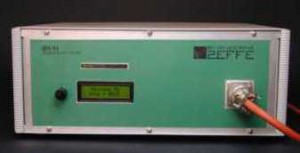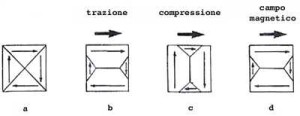
Principles of Barkhausen Noise method
Barkhausen Noise method for the detection of residual stress may be applied only to ferromagnetic materials (iron, cobalt, nickel, and their alloys).
As everybody knows, in these materials, magnetic domains are generally oriented in random directions (image a).

In such conditions, global magnetization is null. If we apply a magnetic field, or a mechanical deformation, a change will be brought to the domain structures (movement of their separating borders or rotation of the magnetization vectors) and the global magnetization of the component will be modified, as well.

In particular, as far as materials with constant positive magnetostrictive (iron and cobalt) are concerned, if they undergo a traction stress along a certain direction, the orientation of the domains will be favoured in the same direction (image b), whereas if a compression stress is applied, a perpendicular direction orientation will be favoured (image c).
When a magnetic field is applied, it tends to cause an orientation of the domains in the direction of the field itself (image d), thus adding its effect to the effect of the traction stress and deducting it from the compression stress, if applied in the same direction.
